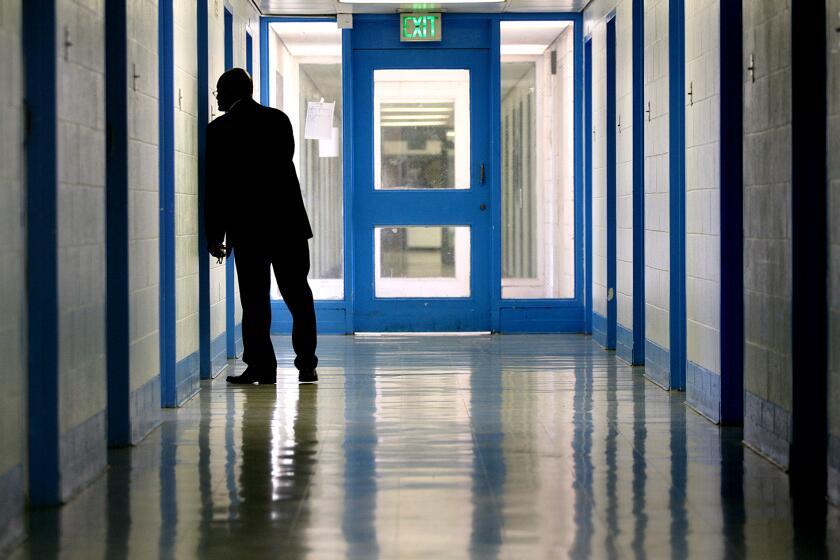More overdose cases in L.A. juvenile halls amid vows to crack down on contraband

- Share via
Less than two months after a teenager fatally overdosed inside one of Los Angeles County’s troubled juvenile halls, four youths were hospitalized after ingesting substances in the span of a few days — a grim sign that the Probation Department’s pledged contraband crackdown has gaping holes.
In a memo dated Monday, Interim Chief Probation Officer Guillermo Viera Rosa outlined a perilous four-day-strech inside Sylmar’s Barry J. Nidorf Juvenile Hall, which houses a facility for those accused of the most serious and violent crimes.
In the span of one hour on June 15, three youths received medical treatment and monitoring after nursing staff believed they may have taken a dangerous substance, according to the memo. Around 4 p.m, a youth who said he had taken Percocet was rushed to an emergency room. An hour later, another youth was rushed to the same hospital. A third refused to go.
Roughly 30 hours later, a fourth youth with constricted pupils was taken to the emergency room after saying he swallowed a pill.
On Sunday, the same three youths treated on Thursday once again “appeared to be under the influence of an unknown substance,” according to the memo.
An 18-year-old was found dead of an overdose Tuesday in an L.A. County juvenile hall, just weeks after a county report raised alarms about the facility. Hours later, a state agency issued a report recommending that the county’s juvenile halls be closed.
One could not stand without falling. Another was vomiting in the trash can in the dayroom. The third was “unable to stay awake.” All said they had consumed either Percocet or fentanyl.
The string of medical emergencies come less than two months after 18-year-old Bryan Diaz was found dead of an apparent overdose in the Sylmar facility — the first time a youth has died at a juvenile hall since 2010, according to a county spokesperson.
Board of Supervisors Chair Janice Hahn said the flow of drugs into the county’s halls and camps was “unacceptable” in a statement Thursday and called for screenings “one hundred percent of the time for one hundred percent of the people who enter our probation facilities.” The Probation Department said in a statement that it would “vigorously seek criminal prosecution” of anyone who tried to bring contraband inside.
In the aftermath of Diaz’s death, both the county supervisors and the Probation Department promised to crack down on the contraband flowing unobstructed into the halls.
“The department has thrown all the possible resources at this,” said Viera Rosa in an interview with The Times soon after Diaz’s death. “This has been an all-out effort to make sure that we do anything within our power to make sure there’s no contraband in our facilities.”
On Thursday, the county commission that oversees the Probation Department grilled agency leaders on how — despite this pledged crackdown — the county had come so close to yet another tragedy.
“There’s been overdoses, sickness and there’s been death. We are deeply concerned and frankly disgusted.” said Probation Oversight Commission Chair Esché Jackson. “The main question I believe I’m left with is how? How are the dangerous things continuing to enter the facilities? And more importantly, how many youth have to die for something to be done about it?”
Kevin Woods, the newly appointed acting chief for the Probation Department’s Detention Services Bureau, provided an unusually blunt assessment.
He said part of the problem was that there were not enough deputies inside the facility because of a critical staffing shortage. Another factor, he said, is the guards who were there weren’t doing their job.
“That was one of the main contributing factors — the lack of supervision,” he said. “And in those cases, where there may have been supervision, the supervision was quite questionable.”
Woods said staff negligence was a “significant factor” in many of the incidents inside their facility and was something officials were trying to “eradicate.” He said there are related investigations underway.
Further jeopardizing youths in county custody is a lack of Narcan. Woods said less than half of the staff at Nidorf have been trained to carry the medication that can reverse an opioid overdose — compared with 93% of active-duty staff at Central Juvenile Hall, the county’s other hall, in Boyle Heights.
State regulators had given L.A. County multiple opportunities to bring the juvenile facilities in Sylmar and Boyle Heights into compliance.
And not all who were trained to carry Narcan at Nidorf actually do so.
Pressed on why, Woods said the reason was “lack of follow through” on the management side. Woods said the department set a June 30th deadline to get everyone trained on using Narcan, though he didn’t think it was going to reach it as staff regularly had to cancel training because they were needed on duty.
He added that the department has also ramped up canine contraband searches, ordered all bags and containers brought into the facilities be made of a clear material and limited outside meal orders in an attempt to stop food deliveries that turn out to be drugs.
Assistant Inspector General Eric Bates said there’d been a “marked improvement” recently in terms of the inflow of pills, particularly fentanyl. But he also said he’d been concerned after reviewing video of staff members entering facilities and placing their plastic foam packages of lunch atop of the X-ray machines — an easy access point for contraband.
“Some of these things — I’m not going to try to explain them,” Woods said. “It makes no sense whatsoever.”
More to Read
Sign up for Essential California
The most important California stories and recommendations in your inbox every morning.
You may occasionally receive promotional content from the Los Angeles Times.













